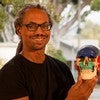Description
About This Video
Transcript
Read Full Transcript
Hi. Welcome to the practice. For today, you're going to want to have a yoga block, a bolster or a cushion, and a blanket or a towel, something to pad your knees with. Let's start off. I'm going to turn a little sideways, and we want to come in and do a hamstring stretch. We're not warmed up at all, so we want to go really gently. Feel your feet into a comfortable position under your hips. Inhale, and as you exhale, let the knees be a little soft. Tilt forward at the hips and come into a gentle forward fold. You may bring your hands or elbows to your knees if you need a little support. Some of you may be bringing your hands all the way down to the floor. And as you come into your yummy forward fold, I want you to bend one knee and straighten the other, and just get a sense of which is the tight side right now in this moment. One side is usually going to be a little tighter than the other. I can feel real clearly for me which side that is. And when you have a sense of which side that is, make a mental post-it note about that side being a little tighter. We want to remember that. Inhale your way up. We want to remember that for later on in the practice. So now get your block and set it. I'm going to set mine on a little diagonal so you can see, but you can set your straight on your mat wherever is good. And I like to have a wall nearby or a chair for my balance. I'm going to take that tighter hamstring side, bring the foot up onto the block, bringing the edge of the block just in front of on the toe side of the heel, and then I'm going to shift my weight and sink into it. I want to relax the foot as I do this. So sometimes people will really activate and stretch the toes. Just relax the toes and lean a steady pressure into the block. We're going into the plantar fascia and it's a really thick strong band of fascia that goes from the front of the heel to the base of the toes. It's literally what gives us the spring in our step as we walk. And we're just going to get it to stretch and it takes some time because it is connective tissue and connective tissue is very slow to stretch. So I'm going to stay at each level. We're going to do three levels. I'm going to stay at each height along the foot about a minute to two minutes. Breathing, staying steady with my pressure and keeping the toes relaxed. And I'm going to slowly come out, just take a pause, and then come back into that same foot. Instead of right in front of the heel, I'm going to go to about the midfoot, relax the toes, and shift weight in to the edge of the block. I might want to roll a little towards the big toe side if it's more the inner foot that feels like the plantar fascia is taught, or I can just go straight on. And I want to stay steady with my pressure. The temptation a lot of times is to rock in and out, resist that temptation, just go in to where you have a moderate sensation in the foot. Not so strong that you can't breathe, but you feel the plantar fascia getting deflected, getting a nice slow glacier speed stretch. We're going to hold it at least a minute, if not two, and breathe. I'm using the wall for a little stability. You may not need the wall. I do today. Or a chair works fine. Even if you have like a broom handle, that can work really fine too. That's about a minute.
I'm going to slowly shift out, give a pause, third time's the charm. So we did in front of the heel, about mid-foot, and I'm going to come up to just the heel side of the ball of the foot. So not right on the ball of the foot, but just a little bit towards the heel from the ball of the foot. And shifting my weight in, relaxing the toes, steady pressure, resisting the temptation to rock in and out, trying to relax the whole foot, letting the block melt into the plantar fascia, while the plantar fascia melts onto the block. And if you don't have a block, you can also use like a tennis ball will work or a lacrosse ball, which is even harder than the tennis ball. That will also work for you. Still breathing, staying about a minute or two. And then slowly shifting off the block, take a pause and just take a moment to feel your footprints. After doing three different layers on that foot, you may feel like you have two different people's feet going. Like I really feel this foot has broadened and widened quite a bit. Now we're going to do a contract relax stretch for that same leg. Staying on that same leg, I'm going to bring the ball of the foot to the block, shift my weight up onto the ball of the foot, and then press down to come up on the ball of the foot. I want to feel my calf muscles working. I'm going to hold this for about 10 seconds. Calf muscles contracting. I'm using the wall for balance. I really need it here. And then I'm going to slowly relax, bringing my other foot back down and leaning into the stretch through the heel. I can even pike a little forward at the hips. I'm going to hold this stretch for about 30 seconds. So this part of the practice, I'm getting those calf muscles to contract, contract, contract. And then when they relax, I can help change the stretch reflex, actually help to lengthen the muscles in terms of their neurological neuromuscular setting. I'm going to come back up, shift forward, press down into the ball of the foot, get the calf muscles working, lifting my posture about 10 seconds here. And at the end of the 10 seconds, shifting the weight back towards the other foot, letting the heel drop down, leaning into the stretch on that same calf and holding the stretch for about 30 seconds, 20, 30 seconds-ish. You don't have to sit there with a stopwatch during your practice. And then shifting forward again, this time bending that knee a little bit. The knee is going to stay bent as you press down and come up onto the ball of the foot. Knee stays bent. You'll feel it's a different set of calf muscles working with the knee bend. The deeper calf muscles, the soleus, quite a bit harder for me. And that's about 10 seconds. So now I'm going to lower down, come onto my back heel, come into the stretch, and I'm going to stretch with my knee bent this time. I need to kind of pike forward a little bit to feel the calf stretch. This one we're going to hold 30 seconds. Of all the three stretches in this set of three, you want to hold the last stretch the longest. So the first two can be 20 seconds-ish. Third one definitely 30 seconds. And then slowly coming up. Now just for fun, come into your starting position and take a forward fold again. Knees can soften as you exhale yourself forward. And then bend one knee and straighten the other. And notice if the tight side is still the tight side, it may have changed. Come back to the center. Slowly come back up. Even if the tight side became the loose side now, we definitely want to do what was the loose side. We don't want that second side to get jealous. So we're going to start off with a plantar fascia massage, bringing the foot up to the block. The block just in front of the heel, just on the toe side of the heel.
Relax the toes. Relax the foot. Shift weight in. Letting the block melt into the foot. Letting the foot melt onto the block. Checking your breathing. And the plantar fascia can be quite intense, especially depending on what kind of shoes you wear. If you've been wearing, if you've been wearing heels a lot, like mostly wearing heels, then this might feel really kind of delicious and wonderful. About a minute for each of the fascia meltings. Plantar fascia meltings. And shifting off. Just take a pause. And coming back on. So we were just in front of the heel. Now come to about the middle of the foot. Sink the weight forward. And this one you might roll a little more towards the big toe or towards the pinky. Right there for me. Everybody's going to have different sensations here because everybody has different feet, different foot history. Still breathing. Kind of a moderate pressure. We want to give the time for the plantar fascia to gradually slowly release. Still breathing. At least a minute.
And then shifting off. Take a pause. And coming back. This time, not in front of the heel, not the mid-foot, but just on the heel side of the ball of the foot. Just that side of the ball of the foot. And sink your weight in. Breathing, relaxing the toes. Notice if you're tightening the shoulders to do this, try to find a way to have ease in the pose even if it's kind of an intense self-massage here. Stay at least a minute. And shifting back. Coming off the ball, off the block. Take a pause. And then bringing that same foot, bringing the ball onto the foot, you're going to shift weight forward onto that foot and press down with the ball of the foot, lifting up and getting that calf to work. Balance can be a little tricky here. And then we're going to slowly shift back, keeping the ball on the block and then come into a calf stretch. Hold this for 20-ish seconds. And shifting forward, lifting the heart, pressing down, coming onto the ball of the foot. Feel the calf muscles working on that side. Still breathing while you're working. Still finding ease in the rest of your body. And then slowly lowering down. Let the heel drop and stretch into that calf. Oh yes. Moaning and groaning is absolutely allowed. Relax the toes as you get that stretch. About 20 seconds. Shifting forward again. This time we're going to bend that front knee, come up onto the ball of the foot, shift your weight forward, keep the knee bent, lift up. You'll feel a deeper layer of the calf muscle working. We're getting into the soleus muscle. And then coming back, shifting the weight back. Keep the knee a little bent, let the heel drop and get that deeper muscle to stretch with the knee bend. This one we're going to hold 30 seconds. The longer hold at the end of the three contract relaxes helps reset the muscle length, reset the proprioceptors, those sensors in the muscle that let us know when we're stretching too far or too fast. It helps to reset those. And then slowly coming up, release the foot from the block, feel into your footprints. You may notice if you were to walk around, you probably have a lot more gasoline in your feet, a lot more energy in your feet. Bring your feet comfortably underneath your hips and let's take a forward fold inhaling. Knees soft as you exhale, hinging forward. And just notice how your hamstrings are feeling. As you come all the way forward, bend one knee, straighten the other and slowly switch. And notice which is your tight side, tighter side, which is your looser side. Now I have my loose side and my other loose side, which is good. Inhale, come halfway up, look down at the floor, get your spine parallel to the floor. We're going to do just a little additional stretch on the back part of this, the back muscle part. Exhale, coming further forward. So this is the same technique of contract and relax. Inhale yourself halfway up, your back muscles are working, your hamstrings are probably working here too. Even the neck muscles are engaged. And exhale forward. Third time's a charm. Inhale up.
Feel the hamstrings working. Feel the back muscles working. These are all connected through the fascia system to the calf and to the plantar fascia. It's all one connective tissue line. And exhale forward. We're going to hang out here forward. If you need a little more height, you can bring that block back and bring your hands onto the block or bring your elbows onto your knees to make it less weight in your low back. Two more breaths here. Good. And then bending the knees deeper. Let the head stay heavy. Inhale your way up, rolling up your spine, coming up to standing. Once you're up at standing, inhale and just take a gentle lean back. You can either reach the arms or stabilize the pelvis. Just get a little length in the opposite direction, opening the psoas. And inhale your way back to center. You can set the block to your side. We're going to slowly come down to seated. I need a little height underneath my hips when I sit down. So I'm going to sit on a bolster and I'm going to take one leg out to the side, bring the other foot in and not all the way in like we usually do for yoga pose, but I'm going to bring it a little forward. I'm going to give myself a little self massage into the calves. The calves, along with the plantar fascia, if you were to count how many reps you do every day, walking, standing, how much these calf muscles work, how much the plantar fasces work, really overworked and under loved, understretched. If you find a tight spot, you can just lean, oh my goodness, lean a little weight there, take a little breath down there, see if you can soften from the inside. And if your thumbs aren't up to it, you can also do this smooshing, oh, with your knuckles. That's very special. I'm just using the flat of my fist. And if that also feels like too much work, find your massage therapist and have them go to town on your calves and your feet. Your feet will thank you. Your legs will thank you. And then let's switch sides. Bring that foot a little forward so you have access to the calf and lean your body weight, either into the thumbs or to the knuckles. If you are using your thumbs, notice if your thumbs really bending back like that, then you use your knuckles. I have thumbs of steel from doing bodywork for 40 plus years. Sometimes I forget that. So knuckles work just fine. You can line your bones up and really use your body weight with the flat of the fist. And release. We're gonna come on to all fours. And I like a little padding under my knees. So I'm gonna bring a blanket in here. And I actually like to bring the blanket in under my shin and kind of float my kneecaps just a little bit. So I'm not burying weight right on my kneecaps. Lift your toes and tuck them underneath. And then very slowly start to sink weight down towards your heels. Now you may find a spot very early where you want to stop.
We're going for a stretch in the plantar fascia again in the bottom of the foot. This may be it. It may be even sooner. But some of you may have a lot of flexibility in that plantar fascia. And if so, you may want to bring a little more body weight by sitting all the way up. We're gonna stay here for two minutes. So if this is already too intense, shift a little weight into your hands. Come to a place where you have that moderate amount of stretch that you can hold for a long time. For some of you, this might not even be enough. You can also slide your knees a little forward while you're sitting up. I'm not gonna do that though. I'm gonna come back to here for me. We're gonna stay here for another minute and 30 seconds while we gradually stretch the plantar fascia again, showing it some love, opening the sole of the foot, opening the area of kidney one, a really important acupuncture point that's on the sole on the bottom of the foot. It's not needled very often, but it's a really a point that is often used moxa on it to heat it up, to stimulate the kidney functions, and to help open that sensation of grounding, grounding your root, grounding your hara, your center, your tan tian down through the legs, into the feet, through kidney one, in the center of the sole of the foot. Still breathing. And these plantar fascia stretches, I do, this is one place where I do use a clock because my internal clock will have me stop this stretch in about 15 seconds. And I know that the fascia takes about two minutes to start to lengthen, so I will use an actual clock for this. And then if you're sitting up, you're going to slowly shift your weight forward, slowly walk your hands forward, untucking the toes and give them a little wiggle.
Remember, it can be quite achy to come out of a yin stretch. And then the hands right underneath the shoulders, tuck your toes again and press down, lift the hips, come into your yummy down dog. Knees can stay soft if you like, and you can shift the hips a little side to side, walking the dog, wagging your tail, come back to center and slowly walk your hands in. Let your head hang heavy, bend the knees a little bit more, roll up your spine from the low back to the mid back, upper back, head's the last thing to come up, and just pause here. Your next inhale, lift the heart a little bit, you can reach the arms out to the sides or bring the hands to the sacrum, just take a little back bend, opening the heart, stretching the psoas. Been spending a lot of time on the back side of the body and we want to remember to give love to the front side of our body as well.
And coming back to center. And we're going to slowly come down to our mats. I'm going to roll this blanket up and set it just to the side. I'm going to bring my bolster in about a third of the way up the mat. I'm going to come down onto my back. And I have my hips on the floor, my head on the mat, and then I'm going to bring my feet to the bolster or cushion. Okay, it's always good to take the time to settle in.
Take your arms out to the sides and we're going to do windshield wipe rasana, one of my favorite poses. Inhaling with the knees and nose pointing towards center. As you exhale, take the knees to one side and roll the head so the nose goes opposite of the knees. As you inhale, knees and nose come back towards center. Following the rhythm of your breath, they arrive at the center at the top of your inhale and pass through the center as you start to exhale towards the opposite side. Knees to one side, nose to the other. Inhale to the center.
Knees and nose arrive at the center at the top of your inhale and pass through the center as you start to exhale into the other side of the twist. And the feet just rocking from the flats of the feet at the top of the inhale, and the feet rocking to the pinky toe edge and big toe edge as you exhale. As you inhale coming back to center, now we're going to add just a little layer of confusion to it. Take a pause at center here. So we're going to do the same thing. Inhale, knees one way, nose the opposite way, but now you're going to take your eyes the same direction as your knees. So your nose is going to go one way and your eyes are going to go the opposite way. And then as you inhale, your eyes, knees and nose come back, everything to center. And then as you exhale, eyes and knees together one way, nose the opposite way. It's going to feel a little bit like trying to pat your belly and rub your head, and that confusion is okay.
So inhaling at the center, eyes, knees and nose at the center. As you start to exhale, take your knees to one side, your nose to the opposite side, your eyes are tracking with your knees going the opposite direction of your nose. As you start to inhale, the eyes, knees and nose all come back towards center, arriving at center at the top of the inhale. And then exhaling, knees one way, nose the opposite way, eyes following the knees. And then inhaling, eyes, knees and nose back to center. I'm going to give you a cheat. There's an easy way to do this. Focus your eyes straight up at the ceiling. Keep your eyes focused at that spot. As you exhale your knees to one side, your nose to the other, your eyes are just going to stay on that spot. But look, my eyes are going opposite to my nose. So that's, it's not really a cheat. It just makes that process a little easier.
We can have this kind of independence and it comes a little easier when we choose to have our focus in a particular way. Inhaling towards the center, exhaling towards the twists. Even the eyes are engaged in the twist. Last inhale towards center and pause at center. From here, you have this rolled up blanket. You have a choice. You can either bring it on top of the bolster or you can bring it underneath your head and neck. That's where I'm going to bring it. I'm going to actually unroll it a little bit and just bring a little tiny part of that roll underneath my head and neck.
Coming to center here and taking a moment to wag your tail, to shift and wiggle, to find your yummiest position. And with those little adjustments you make, find the greatest amount of ease and then extend the legs out over the bolster. Find the place for the arms, find the place for the legs, where you can just surrender. Just let go. Just relax into that softness. We get a lot of opening and softening of the root of the foot and the plantar fascia and the calf and the backside. Rest into that. Let that softness hold you. Let your belly soften.
Your breath can soften. If you find yourself doing ujjayi breathing, just let it go. Let the breath be soft and natural. Soften your face, your jaw. Soften your eyes. Let them rest towards the back of your head, towards the earth.
Just rest here, held, held by the earth. Here, just rest. Here, just rest. You're welcome to stay in shavasana as long as you like. If you are ready to come out at the pose, you can start to deepen your breath again.
Breathe a little movement and awareness out into your edges, into your toes, your fingers. You can lengthen your body. You're slowly bending one knee at a time and rolling your way onto your side. You want to hold the head cushion up. If you had a head cushion, if you didn't, you can just take that bottom arm and raise it up, bring it underneath your bottom ear, and pause on your side with your knees up towards your chest. From your side, let your head stay heavy. Roll that top shoulder a little forward and press the palm into the floor. Slowly roll your way up, one word of breath at a time.
Your head's the last thing to come up. And come to find a comfortable seated position. Sitting up tall, sits bones pressing down, heart right over your hata, your head right over your heart, palms together in front of the heart. Thank you so much for sharing the practice with me today.
Rest Deeply
Comments
You need to be a subscriber to post a comment.
Please Log In or Create an Account to start your free trial.
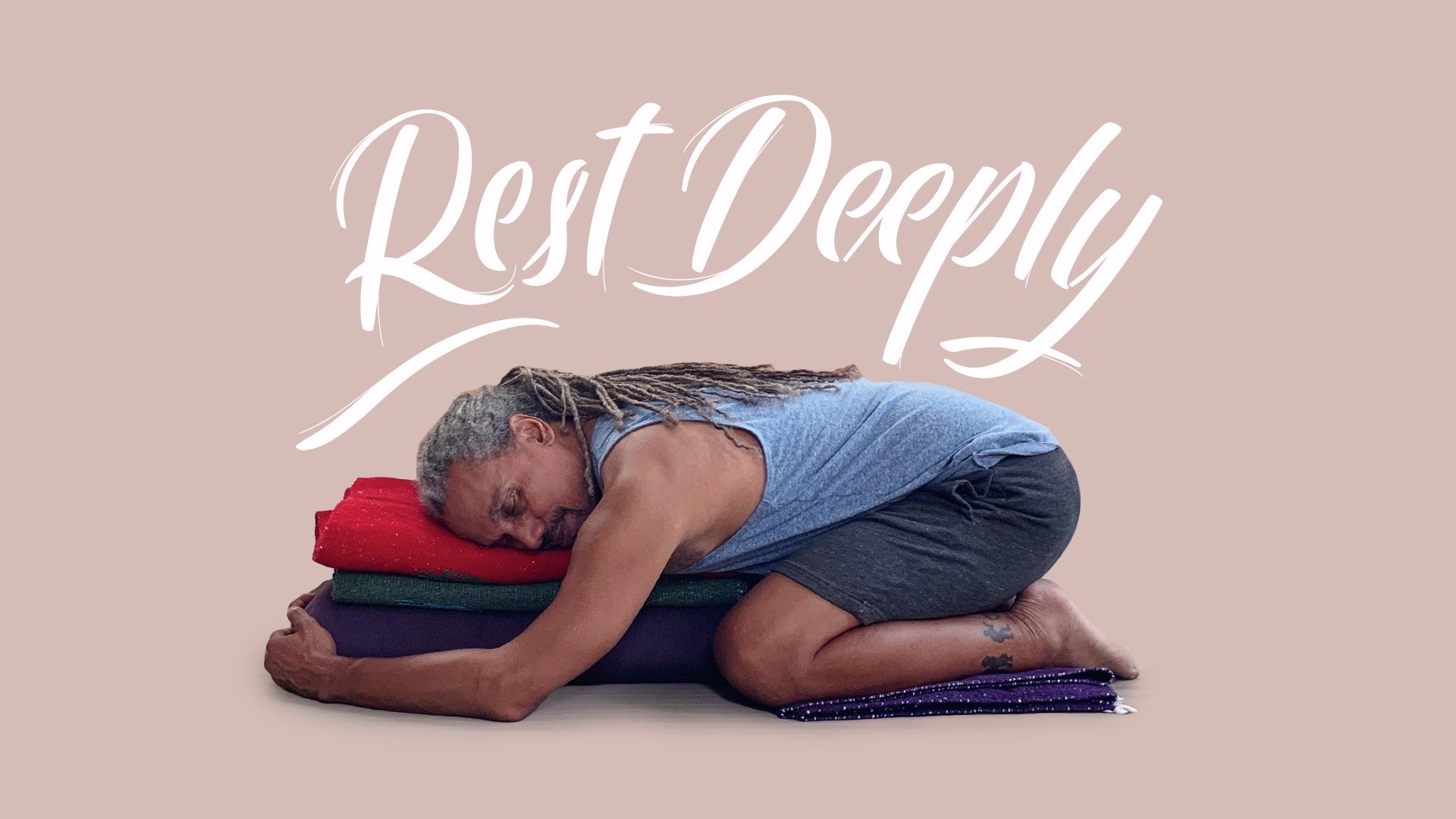
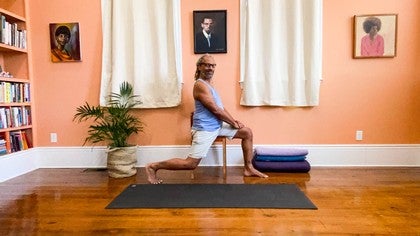
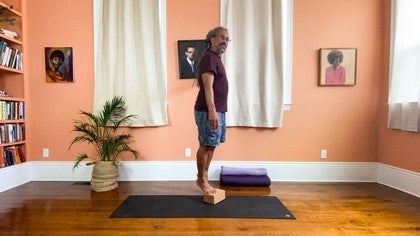
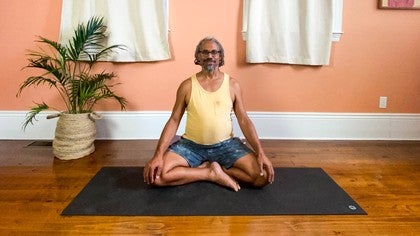




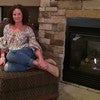

 !
!
